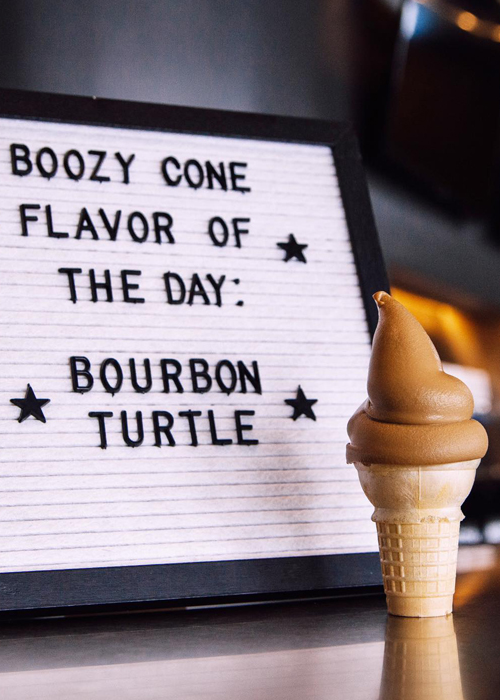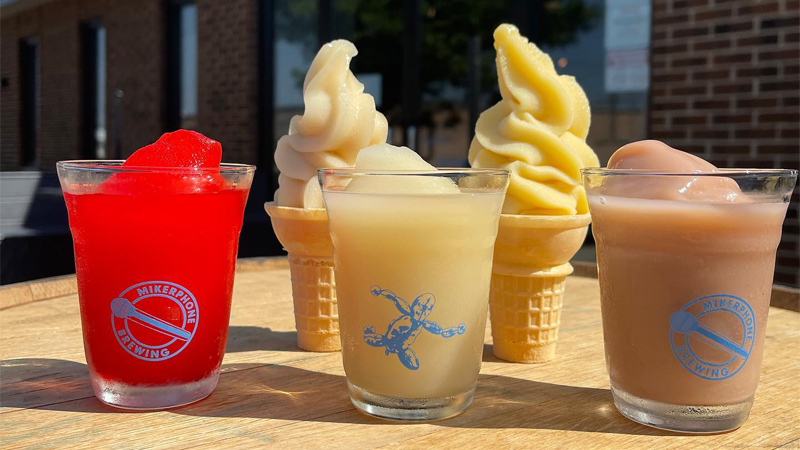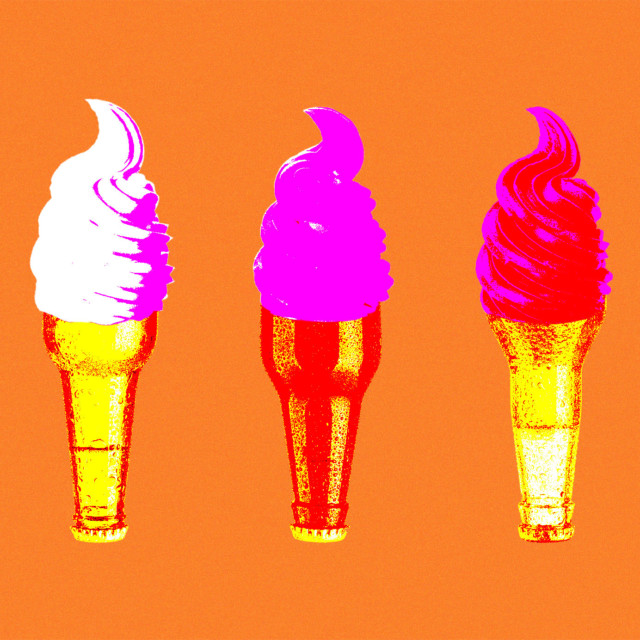This summer, dozens of breweries are trading their shaker pints and Teku glasses for cones and cups. A small but increasing number of beverage producers are using a breakthrough technology to turn their drinks into frozen soft serve–style “ice cream.” In true scoop shop fashion, stouts and fruited sours topped with sprinkles and chocolate sauce are flying out of taprooms as temps increase.
This is all thanks to a creation from WDS Dessert Stations in Huntley, Ill.: a proprietary gel called NEA (which stands for Nitrogen Ingredient Additive, though it was misspelled on the patent) that allows any alcohol to freeze to a near-solid in its Below Zero soft-serve machine. “That’s the stuff that makes the impossible possible,” explains chef and creator Will Rogers, who’s been using the system at catering events for years to serve boozy treats like vodka lemonade cones.
Other beer makers have dabbled in frozen beers before, and slushie machines are nothing new to brewery taprooms, but only recently did soft-serve boozy sundaes make their way onto menus at breweries that have been innovating with the Below Zero Soft Serve Alcohol system, and it’s taken off almost on accident.

“When I first came up with these machines, never in a million years did I think the brewery industry was our main market … [but] these brewers are true chefs. They’re chefs of their trade,” Rogers says. “If you think beer is just Miller or Bud, you’re not thinking of these fruited [sours], stouts with coconut. … That’s ice cream!”
The story begins with something completely opposite of alcohol: During his time running an ice cream shop, Rogers and his team created a massively caffeinated espresso ice cream. That led to thinking about how to come up with a way to get to the other side of the equation: alcoholic ice cream.
After a few years of experimenting with gums and stabilizers from the ice cream industry, “it kind of got my chemistry rolling,” Rogers says of the formulation process. The product is FDA approved, dairy-free (so no, it’s not technically “ice cream”), and fully pasteurized — “it’s even kosher certified,” Rogers adds. “Everything safety-wise, we’ve gone over.” And while one might assume a banana cream pie soft serve won’t pack the same punch as the IPA it’s made from, the alcohol itself isn’t lost at all. So no matter whether you’re putting a high-ABV stout or an easy-drinking Berliner weisse through the machine, you’re still having the equivalent of a beer.
One of the first brewers to start experimenting with the system was Michael Pallen of Mikerphone, whose try-anything approach to brewing matched perfectly with the type of creativity the NEA gel allows. After watching a demo at another nearby brewery, “I basically said to Will, ‘Put my email in your phone, I want to buy it tomorrow. I can’t say no to this thing.’”
Potential for creativity aside, Pallen’s pursuit of a taproom experience that offers something for everyone was also key to the appeal — Mikerphone’s space also has a dedicated non-alcoholic slushie machine so that kids have something fun to drink, too — and putting beer into different physical forms certainly fits the bill. “As the weather warms up and you come out to the tasting room, you just see like 20 people with an ice cream cone and you’re like, ‘This is it, this is why we did it,’” Pallen says.
While nearly all the beers Mikerphone produces get a trial run on the machine, Pallen’s found that the lower-ABV fruited Berliners, as well as cheesecake-inspired beers and pastry beers have been the biggest winners thus far. “Those tend to do the best because it just makes sense in your head that this is almost ice cream, because it’s got the things that are components of ice cream,” he says.
Another early adopter was Jake Schinker of Eagle Park Brewing and Distilling in Milwaukee, who loved the machine from the jump. “When we first put this thing in … it was like Christmas morning — the kind of feeling like [when] you get an awesome toy and you’re like, ‘What can we do with it?’” he says. “It just gets the creative juices flowing and just kind of breeds dumb-but-awesome ideas.”

Eagle Park has the added benefit of its own proprietary spirits to play with, too, though the first experiment was with one of its fudgy imperial stouts. “That was a no- brainer as far as a first go at it,” Schinker says. “But we certainly soon learned that we can do darn near anything with it. We have some pretty talented bartenders here, so as far as cocktail recipe development, this is just like another avenue for them to kind of go wild.”
Since the machine can turn any type of spirit into soft serve (Rogers says they’ve turned straight moonshine into solid form), Eagle Park quickly realized that it could play with not just beer, but cocktails and hybrid drinks. “This is probably the pinnacle of the state of craft beer right now: We make a blue raspberry Kool-Aid inspired hard seltzer. So we use that as a base, and then add our vodka, lemon juice, and cherry puree, and it kind of makes a Bomb Pop flavored ice cream cone,” he says.
Other classic cocktails have gone into the mix: Harvey Wallbangers, Piña Coladas, Daiquiris, and more. The winner so far? “The most popular was our bourbon Old Fashioned,” Schinker says. “It is still Wisconsin, so that worked pretty well.”
Naturally, this is a system that appeals to brewers working in climates less forgiving than Chicago’s or Milwaukee’s. Miami’s J. Wakefield Brewing has been using the system for a while, and owner Johnathan Wakefield is also a fan. “In the warmer weather down here … it goes very well,” Wakefield says. “Now that it’s starting to be 85 to 90 degrees every day, that stuff takes off.”
“That stuff” is mostly a variety of its fruited sours that get turned into creations with toppings including caramel or chocolate sauce and cherries on top. “It’s basically a sundae presentation…minus the banana, I suppose,” Wakefield says.
He says that the stouts don’t move nearly as fast as the sours do, with the biggest winner being the fruit-punch-flavored Sour Haterade. “It comes out this bright red, then we hit that with some cake sprinkles. … It’s like a fruit sorbet, and it’s tart with sweet, so it’s an experience,” Wakefield says.
The capacity to surprise is clearly part of the appeal as well. Just when you thought you’ve found the limits of what can be done with alcohol, here’s a new option to play with. “I mean, I’m 43 years old,” Wakefield says. “I’ve been around the block and seen a lot of things. … It was always the idea that you can never really freeze alcohol. And this is completely different.”
Perhaps the best part of the system is the turnaround time. While slushie machines take hours to spin beer into ice-crystal form, the Below Zero can crank out a fresh batch in just minutes. “We take our beer, de-gas it to get all the CO2 out of it, [mix in] the gel, put it in the machine and within 30 minutes we have the ice cream,” Pallen says, who notes that higher-ABV beers do take longer to turn around. Wakefield goes one further on his fruited sours: “It’s ready in like five minutes.”
The one drawback, though, is the price. The machines sourced by WDS are whisper-quiet (“This thing is kinda like the Ferrari compared to other soft-serves,” Rogers says) and the gel itself is only available via WDS, so breweries or distilleries can expect to spend upwards of $6,000 to get one on-premise.
Even with that expense, most places aren’t adding much of an upcharge for their boozy cones and sundaes, but the novelty is enough to quickly make back the outlay. “I think that first weekend we basically paid off both machines,” Pallen says. “It was insane.”
More spots are adding these to their taprooms each week, but if you’re not near one of these breweries innovating in the soft-serve space, worry not. “It’s kind of crazy,” Rogers says. “We’ve been running our gel in some of the residential Cuisinarts and … yeah, it works. We think we might have a whole new market.”
